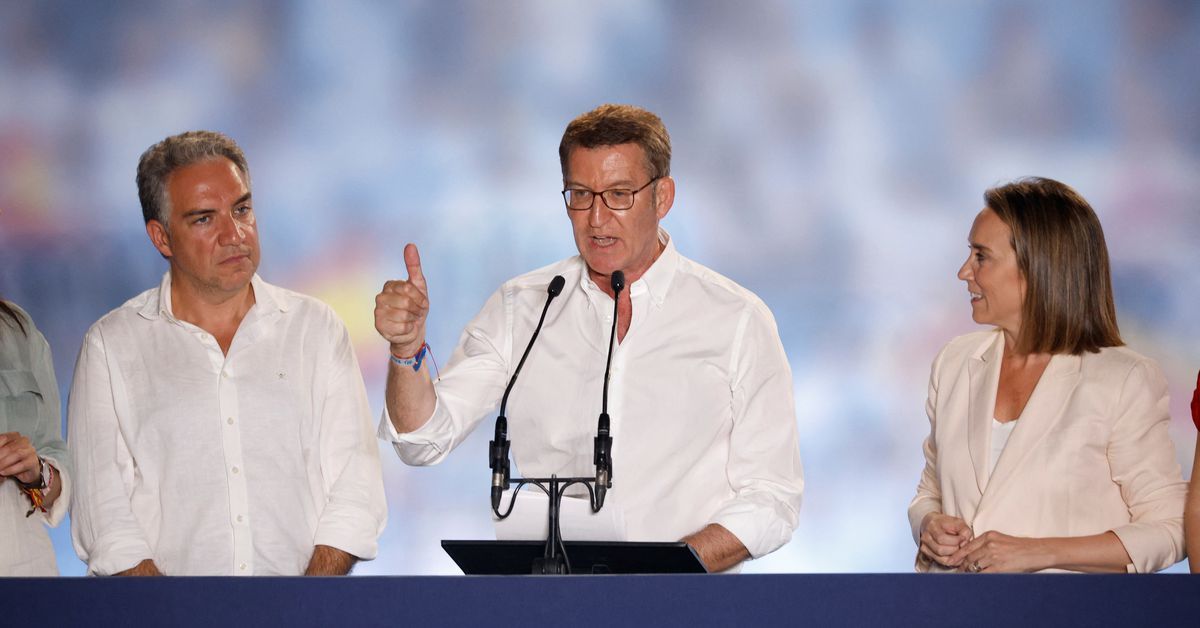
Spain’s parliamentary election on July 23 ended with political gridlock after the right failed to clinch a predicted decisive victory, leaving regionalist parties as kingmakers and the door wide open for a repeat ballot.
The conservative opposition People’s Party (PP) of Alberto Nunez Feijoo beat acting Prime Minister Pedro Sanchez’s ruling Socialists (PSOE) and is likely to take a first stab at forming a government.
It failed to secure an outright majority, however, and even with the support of anti-immigration, anti-feminist Vox, PP’s Feijoo would still lack the votes in the lower house of parliament to secure the premiership.
PP would need the support of smaller regionalist parties.
However, most have said they would not back a government that gave the far-right a role for the first time since Spain’s constitution was approved in 1978, following Francisco Franco’s four-decade dictatorship.
WHY WAS THE ELECTION CALLED?
A national election was due by December, but Sanchez unexpectedly called a snap ballot during the summer holiday season after the left did badly in local elections in May.
The move was an attempt to outmanoeuvre the PP, forcing it to campaign while also negotiating uncomfortable post-local ballot coalition deals with Vox, whose leader Santiago Abascal’s extremist views were incorporated into the agreements.
The PSOE, which ruled in coalition with the far left, partly succeeded by blocking the right and winning an additional two seats compared to the previous election in 2019.
WHAT DID THE POLLS SAY?
Opinion polls on average pointed to a combined PP/Vox winning at least the 176 seats needed for a majority. Two large surveys released on election night also suggested they were likely to secure a working majority. The PP fared worse than predicted, however, while the PSOE outperformed.
WHAT WAS THE TURNOUT?
A total of 37.4 million Spaniards were registered to vote, including 2.3 million abroad.
Almost 2.5 million cast ballots by post so they could travel for holidays.
Turnout in Spain was 70.4%, well above the 66.23% in a repeat election in November 2019 and just below the 71.76% in April 2019, countering fears that voter apathy, holidays and hot weather could dent turnout further.
HOW MANY SEATS DID THE PARTIES WIN?
A total of 350 lower house deputies and 208 senators were chosen. Party lists for the lower house are closed, so voters pick a party rather than a specific candidate, but choose up to three regional senators. Another 57 senators are appointed by regional legislatures.
The PP won 136 lower house seats, 47 more than in 2019, and 120 Senate seats, up from 83.
The PSOE secured 122 and 72 seats, respectively. Its far-left ally Sumar, which includes junior coalition partner Unidas Podemos, won 31 lower house seats.
Vox has 33 lower house seats, down from 52 in 2019, and zero elected in the Senate.
Catalonia’s leftist pro-independence party ERC, which has supported Sanchez in key parliamentary votes since 2019: seven seats, half its 2019 result.
Junts per Catalunya separatists: seven seats.
Basque Country’s leftist pro-independence EH Bildu: six seats.
Basque nationalist party PNV: five seats.
One seat each: Canary islands’ Canary Coalition; Navarran People’s Union (both conservative), Galician Nationalist Bloc (left).
WHEN WILL A NEW GOVERNMENT BE FORMED?
The new parliament must be constituted by Aug. 17, when the oldest lawmaker is nominated temporary speaker. Lawmakers vote the same day to pick a permanent speaker, an event that indicates how blocs are aligning and their relative strength.
King Felipe VI will begin meeting party leaders soon after to hear their pitches, and must then put forward a candidate for prime minister.
There is no time limit for the candidate’s negotiations to form a government.
If the candidate fails to obtain an absolute majority in a parliamentary vote, a re-run requiring only a simple majority (more yeas than nays) is held 48 hours later. If they lose again, the king has to pick a new candidate.
COULD THERE BE ANOTHER ELECTION?
If no candidate secures a majority within two months of the first vote, new elections have to be called.
It took Spain four elections in as many years before a minority Sanchez government took over in early 2020 because coalition agreements could not be reached, with some impasses lasting as long as six months.
Analysts agree that further elections are a distinct possibility.
POSSIBLE GOVERNMENTS:
* PP/Vox
A tie-up between the PP and Vox would reach 169 seats, seven short of an absolute majority. They could potentially attract a further seven seats from conservative regional parties in the Basque Country and the Canary Islands, either into a coalition government or to back the investiture.
* ‘Grand coalition’ of the PP/PSOE.
Sanchez ruled out this option on several occasions before the election.
* New leftist minority government.
A combination of all left-wing forces would fall short of a majority with 167 seats so a win in the first vote is almost impossible. The support or abstention of all regional parties in the second vote would bring more yeas, but Sanchez needs to negotiate each deal separately.





